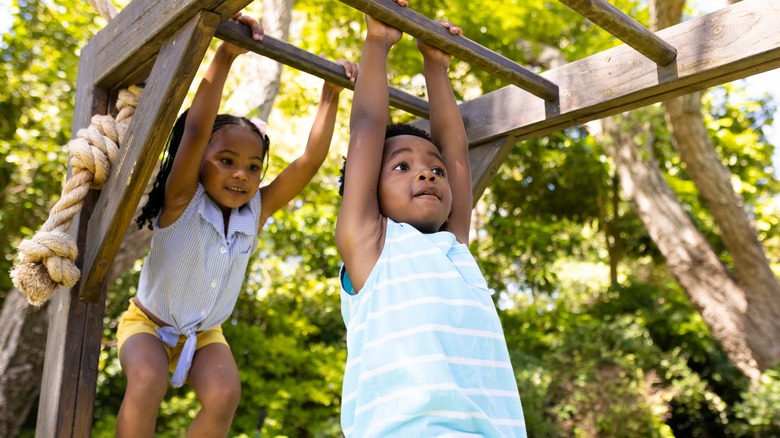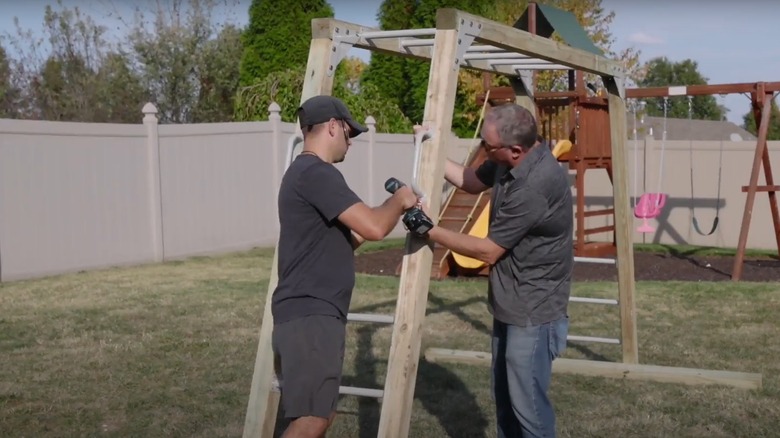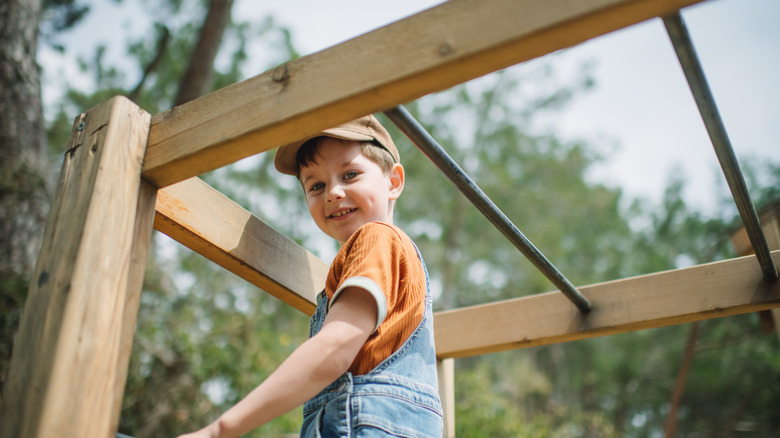Add Adventure To Your Backyard With These DIY Monkey Bar Ideas
We may receive a commission on purchases made from links.
When it's time to give the kids an activity location in the backyard, maybe you want to purchase a backyard playset. However, considering even basic sets cost hundreds of dollars, a DIY option may be better for your budget. And if you have older kids who have a lot more energy to burn than a basic swing set can handle, maybe you should consider DIY-ing your own set of monkey bars. By relying on a DIY project, you can make the monkey bars as long and high as you want. If you've done some budget-saving projects yourself in the past, like DIY-ing your backyard landscape, you likely can build these monkey bars, too.
Perhaps the easiest option is to purchase a kit that has all the metal pieces you need, including the steel rungs the kids hang from, brackets, handles, and all the screws, lag bolts, and washers you need for a secure installation. You then supply the treated wood that results in the frame for the unit. You can purchase this kit at Amazon for about $150. You'd then need at least eight 4x4-inch pressure-treated posts of 8 feet in length. Such posts cost about $10.50 apiece at Home Depot.
The kit at Amazon includes an installation video that you can use to be sure you're constructing the wood frame correctly. The brackets have grooves that ensure a smooth installation with the wood pieces at the correct angles. This layout does not require burying the posts in concrete.
Steps to follow to build your own backyard monkey bars
Dozens of different plans for building monkey bars for the backyard exist on the internet and YouTube. We'll give you the basic steps for building this type of playset, but you may want to make tweaks and adjustments to create monkey bars that fit your needs. Start by burying 4x4-inch pressure-treated wood posts at the four corners of the layout. Purchasing 10-foot-long posts and burying about 40 inches of them in the ground with quick-dry concrete should provide plenty of stability by following the one-third rule. Buying 12-foot posts and burying them 4 feet works, too. Make sure they are perfectly level and straight. Give the quick-dry concrete enough time to set, usually about an hour, before taking the next step.
Now add the rails across the top. You can use 2x4-inch or 2x6-inch boards for this step. The length of these boards needs to span the entire length of the monkey bars. Most DIYers select 12-foot boards. Because kids will be using them, you may want to sand all the boards to remove any chance of splinters or rough edges. Most DIYers choose to purchase pre-made rungs that have square connectors with screw holes on the ends of the rungs. This design greatly simplifies attaching them. Buy eight of them with a 16.5-inch length at Amazon for about $50. You then can use pressure-treated 2x4-inch boards to build steps on either end and to add stability to the frame.
Keeping your DIY monkey bar project within a lower budget
Buying the kit and providing your own lumber results in a total cost of about $250. You may prefer a cheaper option that's closer to $100 or $150. A shorter set of monkey bars with fewer rungs will save some money on the overall cost. If you have kids 5 years old or younger, the rungs should be no more than 5 feet off the ground. For kids aged 6 to 12, you can go as high as 7 feet off the ground for the rungs. Taller monkey bars take more lumber, so they cost more, but your kids won't outgrow them as quickly, either.
The spacing of one rung to the next also plays a role in the cost of the project. If the rungs are tighter together, you'll need more of them and will spend more. A standard spacing is about 16 inches, although anywhere from 14 inches to 18 inches is workable. Younger kids with shorter arms may need the rungs to be spaced together tighter than older kids.
Finally, you may be able to save money — and time — by not burying the posts in concrete. Attach 8-foot, 4x4-inch posts to the legs on either end to provide stability. This layout may be better for smaller kids who don't have much weight and won't put as much stress on the stability of the unit as larger kids or adults.


